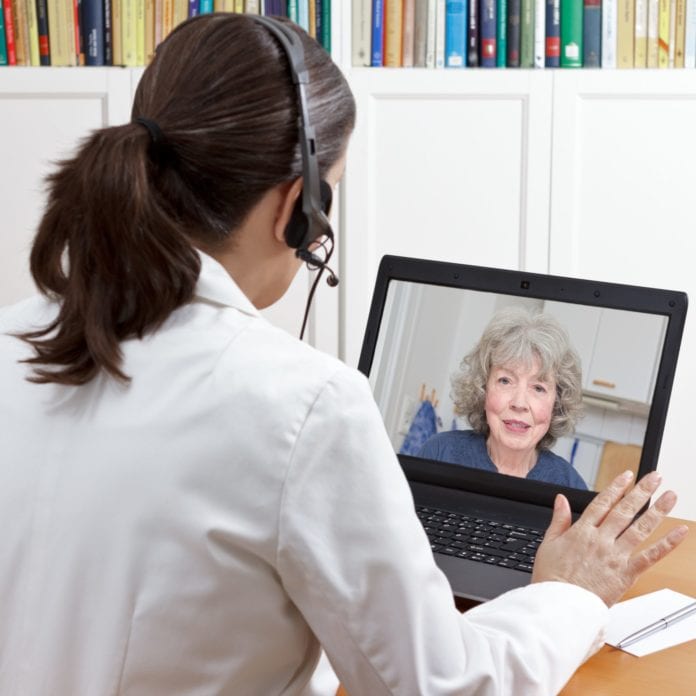Telehealth, or telemedicine, uses modern electronics and telecommunications technology to connect patients to medical services, long-distance. Wireless is playing a growing role in this important and growing space. As it continues to advance, telehealth is now taking healthcare to new levels in areas which is important for doctors, patients, tech companies and investors.
Many different medical specialties are finding new ways to use this new technology to improve healthcare like neurology, radiology, oncology and in the emergency room.
That’s why telehealth is a rapidly growing segment of the healthcare marketplace. And using it for emergency care is a new area of focus that is helping this segment improve the delivery of life saving services.
Telemedicine medical devices use AI, IoT, cloud and wireless
There are a wide range of different companies and technologies in this space. And as each year passes, more breakthrough ideas are coming into focus.
These include Artificial Intelligence, the Internet of Things, the cloud, wireless and wire line telecommunications, smartphone like technologies including wireless medical devices, and more.
That means, going forward this slice of the pie will continue to grow larger and become more important.
That’s why this is one of the most exciting times in the history of healthcare advancement.
Telehealth coming out party during COVID-19
We experienced new ways to think about caring for patients during the last few years as we wrestled with the pandemic Covid-19.
This was the coming-out-party for telehealth, which has been with us in different forms for a while already.
And just as this pandemic ushered in this new wave of medical technology, it won’t be the last. Over the years, we have experienced many pandemics to varying degrees.
Going forward, each new wave should also be a powerful growth engine for this entire space.
This time around many doctors and patients fumbled around with new technology and didn’t do as good a job as they had when things were in-person. This was part of the learning process.
However, during this time when we stayed apart, telehealth was a great way to get the care you needed while remaining safe at home.
Whether because of a pandemic or just limited patient mobility, telemedicine saves lives. That will only get better and stronger moving forward.
Telemedicine in healthcare is here to stay
As with anything else, it takes time and effort to change the way we think about medicine, the way we provide it, and the way we access it.
This is not unlike a decade and a half ago when the iPhone and Android were created. We were slowly learning and changing. Today, fifteen years later this marketplace is huge and impacts everyone in every aspect of their lives.
The app market exploded from under 500 to millions today.
Telehealth will take the same path. It is and will remain one of the most important areas of healthcare going forward. We will just have to get used to this new technology.
The point is telehealth and telemedicine are here to stay.
There are many examples. Consider tele-triage for emergency care. Whether at a hospital, clinic or out in the field, doctors must determine which case has priority. Tele-triage let’s doctors and other practitioners communicate with patients, remotely, from anywhere in the world, live.
Remote monitoring is another strength of telehealth services. This enables doctors to monitor patients, even when they are not nearby. This is done with wearable medical devices.
Wireless, AI and IoT connect patients using telehealth to doctors
Follow up care is yet another important aspect of telehealth. When it is difficult for patients to make the journey to see the doctor because of distance or mobility, telehealth is the next, best thing to being there.
Much of ongoing treatment, like after-care can be done between the doctor and the patient who could be sitting in their own living room or kitchen table.
Smartphones, wireless technology, computers and the Internet are the technologies we all use every day which can link patients to doctors and tele-health-care services.
Emergency care just one slice of telehealth pie
Emergency medicine is just one chapter to the growing telehealth story.
There are many companies, large and small, who are involved in this exciting transformation of the healthcare industry. And we have seen some amazing advancements in recent years.
A few of them include the big, brand name healthcare specialists like Mayo Clinic, or smaller and fast-growing providers like Teladoc Health or Medicai which provide new and more effective ways to provide services.
While these companies don’t have the name recognition as traditional healthcare giants, they represent tomorrow.
Breakthrough telehealth providers like Mayo Clinic, Teladoc, Medicai
Mayo Clinic says they use telehealth to access digital information and communication technologies to provide healthcare services remotely and manage your health care. Many other hospitals and medical institutions are increasingly using telehealth as well.
Teladoc started several years ago and got a boost with the Covid-19 lockdowns. They provide a way for patients to see the doctor, remotely. They are a multinational telemedicine healthcare provider working with AI and analytics.
Medicai is a telehealth platform which bridges patients, doctors, hospitals, clinics and more with real-time, cloud collaboration. They provide in-the-cloud, real-time collaboration between patients and doctors with images like CT, MRI, PET-CT, and more.
There are so many other examples and stories about companies and new technologies which are transforming the healthcare space with new ideas.
Companies and technologies transforming healthcare with telemedicine
Companies like these are some of the most exciting and interesting stories today. This is such an important sector, and I will continue to follow it to find interesting stories to tell you about.
You see, telehealth and telemedicine are still in the very early stages of what will be a massive and ongoing growth wave and shift in healthcare.
Any way we slice the telehealth pie, this is the future, and it looks brighter than ever.

